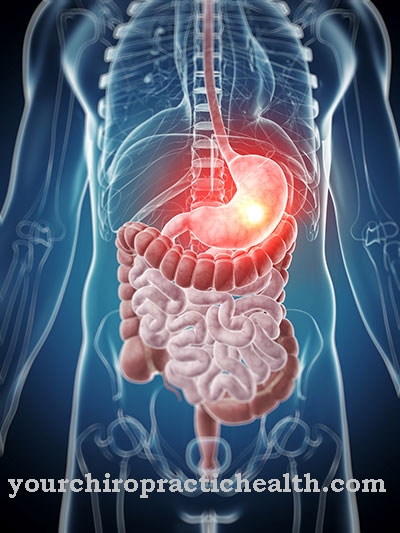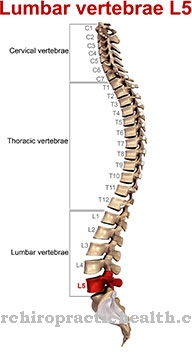Under one Mitral stenosis a heart valve defect is understood. There is a constriction at the opening of the mitral valve.
What is mitral stenosis?

© Peter Hermes Furian - stock.adobe.com
In medicine it is Mitral stenosis also as Mitral valve stenosis known. There is a narrowing on the mitral valve, which separates the left ventricle from the atrium. The stenosis leads to an impairment of the blood flow between the left ventricle and the left atrium.
The mitral valve normally has an opening area between 4 and 6 cm². If this area sinks to about 2 cm², we speak of mitral stenosis or mitral valve stenosis. This creates a severe narrowing that usually leads to pronounced symptoms. The complaints are even more severe when the opening area of the heart valve drops below 1 cm².
Mitral stenosis is one of the most common acquired heart defects. Females suffer from the disease more often than males. Overall, the share of mitral valve stenosis in all heart valve defects is around 20 percent. In Europe, around three to four percent of all people suffer from a disease of their heart valves.
causes
In most cases, mitral stenosis is caused by rheumatic fever. This is caused by the action of bacteria such as class A streptococci. This often affects the inner skin of the heart. The bacteria cause inflammation of the inner lining of the heart (endocarditis), which later spreads to the mitral valve.
The heart valve is also composed of tissue from the inner lining of the heart. Sometimes mitral stenosis does not appear until 20 or even 30 years after a rheumatic fever. In the case of acute rheumatic fever, about half of all patients develop a heart valve defect. The mitral valve calcifies, which in turn triggers its narrowing and restricted movement.
Mitral regurgitation is often caused by inflammatory-degenerative processes or a survived heart attack. There is thus the risk that these processes affect parts of the heart that are important for the stabilization and opening of the valve apparatus. If these structures are impaired, the mitral valve leaflets fold over when the heart is pumping into the atrium.
In the case of mitral regurgitation, medical professionals differentiate between primary (organic) and secondary (functional) triggers. The most common primary causes include infections that directly damage the mitral valve. If there is a secondary cause, on the other hand, there is an underlying disease that negatively affects the mitral valve. Occasionally, autoimmune diseases are responsible for mitral stenosis.In some patients, the heart valve defect is already congenital.
Symptoms, ailments & signs
Mitral stenosis is noticeable through shortness of breath. It is caused by a backlog of blood towards the lungs. The back pressure causes the liquid part of the blood to be pressed into the lung tissue, which makes it difficult for the oxygen to be transported into the blood, as a result of which the patient suffers from breathing problems.
In most cases, the shortness of breath shows up during physical exertion, as the heart is more active. In severe cases, breathing difficulties are possible even at rest. Some patients also suffer from coughing up blood (hemoptysis). This leads to the escape of solid blood components into the lungs, which leads to a reddish discoloration of the sputum.
If the mitral stenosis lasts for a long time, changes in the heart are possible due to the pressure. There is a risk that the expansion of the left atrium will trigger atrial fibrillation. Atrial fibrillation goes hand in hand with disorders of the blood flow, so that there is a risk of blood clots forming. If these are carried off into the body, further clinical complaints arise.
The right heart strain results in a backlog of blood in the right heart, which can be noticeable in leg edema or an enlarged liver. Some patients also have blue skin.
Diagnosis & course of disease
If mitral stenosis is suspected, the doctor first looks at the patient's medical history. A physical exam will then take place. The doctor pays attention to suspicious heart murmurs with a stethoscope. Other possible examination methods are an EKG, an X-ray examination, a computed tomography (CT), a magnetic resonance tomography (MRT) and an echocardiography or a Doppler echocardiography.
A right or left heart catheter examination is also possible. The course of mitral stenosis is usually more favorable than that of other heart valve defects. In severe cases, however, the life expectancy of the patient is shortened considerably without appropriate therapy. Those affected are threatened with death from right heart failure or an embolism.
Complications
As a rule, mitral stenosis can lead to life-threatening conditions and complaints for the patient. The disease primarily causes shortness of breath, which can continue to lead to a loss of consciousness and, in the worst case, to death of the patient. Likewise, the individual organs are no longer supplied with enough oxygen, so that they can be damaged.
Those affected suffer from a bloody cough and from severe tiredness and exhaustion. Mitral stenosis also enlarges the liver, which can lead to pain and other discomfort. The reduced oxygen transport also results in a blue-colored skin. If mitral stenosis is not treated, the affected person can also die from this disease.
In most cases, treatment is carried out by taking medications that can relieve the symptoms of mitral stenosis. There are usually no complications. These usually only occur if there is no early treatment for the disease. In severe cases, surgery may also be necessary. It cannot be universally predicted whether this disease will lead to a reduced life expectancy.
When should you go to the doctor?
Disturbances and irregularities of the heart rhythm are signs of a health impairment that need to be examined and treated. If there is a problem with breathing, a doctor will also need to be clarified. There is cause for concern if there is difficulty in breathing, an increased pulse rate or rapid fatigue.
If the daily obligations cannot be carried out due to exhaustion or fatigue, a doctor should be consulted. Sleep disorders, headaches, malaise and a feeling of illness should be assessed by a doctor. If the general resilience drops and physical activities can no longer be carried out as usual, a doctor is required. Consult a doctor if you withdraw from social or sporting activities, if you are irritable or if you feel less well-being.
If anxiety or panic develop due to shortness of breath, the person concerned needs help. A pale complexion and a blue coloration of the lips indicate an insufficient supply of the organism with oxygen. A doctor's visit is necessary so that there is no life-threatening condition. Swelling or a feeling of pressure inside the body are further indications of an existing illness. If functional disorders develop, a diffuse pain sensation develops or digestion is impaired, a doctor is required. If you cough up blood, you should see a doctor as soon as possible.
Treatment & Therapy
Mitral stenosis is treated either conservatively or surgically. In mild cases, the patient has to take physical rest and take medication such as diuretics. If there is also pulmonary hypertension, vasodilators such as nitrates are administered. If there is a risk of cardiac embolism due to atrial fibrillation, the patient is given beta-blockers or blood-thinning drugs to counteract the embolism.
If conservative treatment is not sufficient to improve mitral stenosis, surgical therapy can be useful to enlarge or restore the narrowed mitral valve. Balloon dilation is one of the best practices.
A balloon is inserted into the mitral valve region with a small catheter and inflated, which causes the heart valve to expand. Another procedure is the commisurotomy. With this method, the surgeon removes the calcified valve tissue and thus restores the functionality of the mitral valve.
Outlook & forecast
Mitral stenosis is one of the more slowly progressive diseases. This means that it often takes years for it to manifest itself clinically in those affected. Mitral stenoses are also often associated with bacterial infections and degenerative processes. In the long term, the disease leads to a significantly reduced pumping capacity of the affected heart. This often manifests itself in a clinical appearance with shortness of breath and a reduced resilience of the patient.
A completely untreated mitral stenosis would certainly lead to an early death of the patient. However, the prognosis is different for each individual patient, especially because the mitral stenosis usually progresses rather insidiously until they finally become clinically noticeable. The patient's heart changes anatomically and functionally in order to adapt to the disease as well as possible. However, this works differently for each patient.
The survival rate for the next 8 years is 89% for those who require surgery. The prognosis of those affected is essentially dependent on how strong the pumping capacity of the diseased heart is. For those patients who have a more normal pumping function, the survival rate for 10 years is around 72%. Whereas in patients with impaired pumping function, the survival rate for 10 years is 32%. Sudden deaths are generally relatively rare at around 0.8%.
prevention
In order to prevent mitral stenosis, avoiding general underlying diseases is recommended. So it is important to counteract a heart attack or diabetes, which can be done, for example, through a healthy diet.
Aftercare
Follow-up care for mitral stenosis is important after a surgical procedure in which a special mitral clip was used. After a night in the clinic's intensive care unit, the patient is transferred to the normal hospital ward for around three to five days. There he can get up again soon and move around. Usually an improvement in symptoms such as shortness of breath can be felt shortly after the procedure.
After the operation, the patient is given certain drugs, such as acetylsalicylic acid (ASA) or clopidogrel. Both belong to the group of active substances called platelet aggregation inhibitors. These have the property of counteracting the clumping of thrombocytes (blood platelets) in the blood, which can prevent the formation of dangerous blood clots. While clopidogrel is given for about a month, acetylsalicylic acid, which is less effective, lasts for at least six months.
If the patient also suffers from symptoms such as heart failure, other drugs such as ACE inhibitors, beta blockers, diuretics or aldosterone antagonists must be taken. Every three to six months after the operation, your family doctor will have a follow-up examination. A cardiologist should also be seen once a year to check the condition of the heart and mitral valve. It is also advisable to take part in an outpatient heart failure group after completing inpatient rehabilitation measures.
You can do that yourself
Adaptation and self-help when mitral stenosis is detected depends very much on the severity of the stenosis and on the possible accompanying symptoms such as atrial fibrillation. In serious cases, which are also expressed by physical inefficiency and shortness of breath, any physical strain should be avoided. Even if the sensation is subjectively better than would be expected from the objective finding, physical and mental stress peaks should be avoided as far as possible. Mental or psychological stress peaks should be avoided if possible, because the sudden release of stress hormones by the sympathetic nervous system due to the rising blood pressure leads to additional stress on the left atrium.
In the case of less serious mitral stenoses, which are hardly noticeable subjectively in the normal daily routine, endurance sports such as golf and Nordic walking without incalculable stress peaks are recommended. In contrast, ball sports such as soccer, tennis and handball should be avoided because they are associated with strong and previously unforeseeable peaks in stress. Sports with high static loads, such as weight lifting and bodybuilding, can have an equally unfavorable effect. Those affected should therefore refrain from such sports. How high the individual burden may be should be clarified beforehand by a detailed examination of the mitral stenosis.
Relaxation techniques that use mental exercises such as meditation or yoga to contribute to deep relaxation and relieve the heart are also helpful.




.jpg)






















